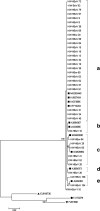Human bocavirus (HBoV) in Kuwait: molecular epidemiology and clinical outcome of the virus among patients with respiratory diseases
- PMID: 32579103
- PMCID: PMC7481742
- DOI: 10.1099/jmm.0.001219
Human bocavirus (HBoV) in Kuwait: molecular epidemiology and clinical outcome of the virus among patients with respiratory diseases
Abstract
Introduction. Globally, human bocavirus (HBoV) has been detected in respiratory samples from patients suffering from upper and lower respiratory diseases. In Kuwait, little is known about the epidemiological and clinical characterization of the virus and genetic characterization of the virus as a respiratory pathogen is unknown.Aim. This study aims to explore the molecular epidemiology and clinical features of HBoV isolates in patients with respiratory diseases.Methodology. Retrospectively, between 2018 and 2020, 5941 respiratory samples from patients with respiratory diseases were screened for respiratory viruses using multiplex real-time PCR. Samples that were positive for HBoV were then subjected to NP1 and VP1/PV2 phylogenetic analysis.Results. HBoV was detected in 1.9 % of the patients, with a peak incidence of infection among children <1 year old. Co-infection with other respiratory viruses was observed in 56.8 % of HBoV-positive patients. Fever, cough and respiratory distress were the most common clinical features of HBoV infection. Phylogenetic analysis of the Kuwaiti HBoV isolates revealed that all the isolates were of the HBoV-1 genotype, with slight sequence variations among the isolates.Conclusion. This study illustrated the predominance of the HBoV-1 genotype in patients with respiratory diseases in Kuwait with minimal genetic variability. It also highlighted the clinical features of HBoV-1 infection, verifying its role in respiratory diseases.
Keywords: Kuwait; bocavirus; epidemiology; respiratory patients.
Conflict of interest statement
The authors declare that there are no conflicts of interest.
Figures



Similar articles
-
Human bocavirus isolated from children with acute respiratory tract infections in Korea, 2010-2011.J Med Virol. 2014 Dec;86(12):2011-8. doi: 10.1002/jmv.23880. Epub 2014 Jan 4. J Med Virol. 2014. PMID: 24390980 Free PMC article.
-
Human bocavirus in children with acute respiratory infections in Vietnam.J Med Virol. 2014 Jun;86(6):988-94. doi: 10.1002/jmv.23789. Epub 2013 Oct 12. J Med Virol. 2014. PMID: 24123072 Free PMC article.
-
Epidemic and molecular evolution of human bocavirus in hospitalized children with acute respiratory tract infection.Eur J Clin Microbiol Infect Dis. 2015 Jan;34(1):75-81. doi: 10.1007/s10096-014-2215-7. Epub 2014 Jul 29. Eur J Clin Microbiol Infect Dis. 2015. PMID: 25070494 Free PMC article.
-
HBoV-1: virus structure, genomic features, life cycle, pathogenesis, epidemiology, diagnosis and clinical manifestations.Front Cell Infect Microbiol. 2023 May 17;13:1198127. doi: 10.3389/fcimb.2023.1198127. eCollection 2023. Front Cell Infect Microbiol. 2023. PMID: 37265497 Free PMC article. Review.
-
Human bocavirus-the first 5 years.Rev Med Virol. 2012 Jan;22(1):46-64. doi: 10.1002/rmv.720. Epub 2011 Oct 28. Rev Med Virol. 2012. PMID: 22038931 Review.
Cited by
-
Demographic and clinical characteristics of human bocavirus-1 infection in patients with acute respiratory tract infections during the COVID-19 pandemic in the Central Province of Sri Lanka.BMC Infect Dis. 2023 Jun 22;23(1):425. doi: 10.1186/s12879-023-08312-x. BMC Infect Dis. 2023. PMID: 37349687 Free PMC article.
-
Prevalence and Molecular Characterization of Human Bocavirus Detected in Croatian Children with Respiratory Infection.Viruses. 2021 Aug 31;13(9):1728. doi: 10.3390/v13091728. Viruses. 2021. PMID: 34578309 Free PMC article.
-
Prevalence and Genetic Characteristics of Human Bocaviruses Detected in Patients with Acute Respiratory Infections in Bulgaria.Int J Microbiol. 2021 Nov 15;2021:7035081. doi: 10.1155/2021/7035081. eCollection 2021. Int J Microbiol. 2021. PMID: 34819956 Free PMC article.
-
Seasonal Coronaviruses and Other Neglected Respiratory Viruses: A Global Perspective and a Local Snapshot.Front Public Health. 2021 Jul 5;9:691163. doi: 10.3389/fpubh.2021.691163. eCollection 2021. Front Public Health. 2021. PMID: 34291031 Free PMC article. Review.
-
Human Bocavirus in Childhood: A True Respiratory Pathogen or a "Passenger" Virus? A Comprehensive Review.Microorganisms. 2023 May 9;11(5):1243. doi: 10.3390/microorganisms11051243. Microorganisms. 2023. PMID: 37317217 Free PMC article. Review.
References
MeSH terms
Substances
LinkOut - more resources
Full Text Sources

